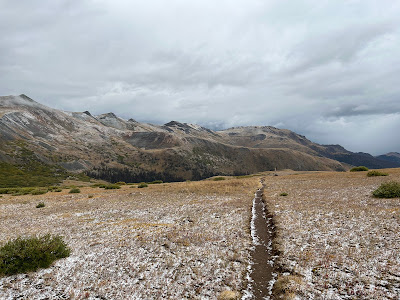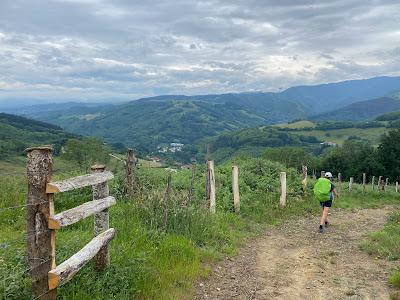 |
| Snowy morning at Baldy Lake |
After 353.1 miles, more than 65,000 feet of climbing, and a week of hard frosts, hail, sleet and even a bit of snow on the Colorado Trail, I had had enough.
I called an audible and headed back into civilization on Tuesday 9/19, after a particularly memorable 21-mile trek that took me up through the 12,611-foot pass below San Luis Peak, then sent me in a mad dash down the other side of the mountain and up again through the 12,383-foot continental divide in a largely unsuccessful effort to avoid a series of icy thunderstorms.
I originally had been toying with the idea of hoofing it the whole 28 miles down the mountain to the silver-mining town of Creede that night. But I didn’t want to deplete my headlamp battery in the dark, and I was cold and wet and concerned that I was flirting with hypothermia. So I ended up pitching an emergency trailside bivouac to escape some of the worst of the evening’s final storm.
 |
| Hard frost |
Too much winter had arrived too soon for me.
The mother of all my mistakes on the trail was seriously underestimating how hard the route would be for me.
Where I had planned to hike 20 miles in a day, I often could only manage half of that or, on one particularly enlightening occasion, a total of six miles.
As a lifelong sea-level resident, the trail’s elevation was a major challenge for me. During the first two weeks of my adventure, I often had to rest after as few as 25 paces at the higher elevations, to let my fluttering, oxygen-starved heart recover before it exploded. Over many of the uphill sections, I was lucky to average one mph. It wasn’t until Day 15 that I started feeling reasonably comfortable hiking at 11,000 feet.
 |
| Seriously frozen zipper |
I also often found some of the trail’s steeper downhill sections to be almost as difficult and slow-going as the uphill ones. Many of the descents were boobytrapped with loose rocks and slippery, Grape-Nuts-sized granite gravel. Much of the trail surface has been tilled by years of foot, equestrian and mountain bike traffic. My trekking poles saved me many times as my feet regularly slid out from under me.
The harsh reality was that the distance I could travel in a day was inversely proportional to the trail’s elevation and to how steep it was. And much of the trail is elevated and steep, yo-yoing between 9,000 to up to more than 13,000 feet above sea level.
 |
| Bear Grylls answer to frozen shoes |
One of the key consequences of overestimating my hiking prowess was that the trek was taking a lot more time to do than I had anticipated. I also ran short of food between resupply points on several occasions. There was enough of a calorie deficit that I lost 15 pounds during my trek.
Another more serious blunder I made was underestimating how cold it might get on the trail. It was almost 100 degrees on August 17, the day I started my SOBO hike in a Denver suburb.
But during the final days of my trek in mid-September, the nighttime temperatures regularly dropped below freezing, so that my tent was regularly sheathed in ice in the mornings. I wasn’t really equipped to cope with this sort of cold. At very least, I should had a warmer puffy jacket. In retrospect, I would have had a lot nicer weather window if I had started the hike at the beginning of August instead of the middle of the month.
One smart move I made was to trade my Chaco sandals for a pair of trail runners in Salida. I walked the first 253 miles of the trail to the town in the sandals (thus the trail name Chacoman) but decided to switch to the shoes after learning that it had already begun snowing at higher elevations.
Another smart move was to buy a serious Gore-Tex raincoat during a rest day in Frisco. I donated the paper-like Frogg Toggs raincoat I had been using previously to the hiker box at my motel. I decided to upgrade after a firehose-like torrential downpour flooded my campsite one night. Serious storms require serious rain-gear. I ended up wearing the Gore-Tex raincoat during most of rest of days of my hike. It not only kept out the wet but helped keep me warm.
 |
| Carrie, Tulsa, was borderline hypothermic but declined help |
One of my dumber moves, considering how much precipitation there was during the final days of my trek, was forgetting to bring my rain kilt. Cold, wet legs and feet are no fun.
My glove liner/shells were very handy, though, so to speak. So kudos to me for remembering to bring those.
After my icy, mostly sleepless night on the slanted lumpy side of the mountain, I was exhausted when I finally arrived in Creede the following day.
As I checked into the Creede Hotel on that sunny afternoon, I knew I had taken this path as far as I was going to take it, at least for this year.
 |
| Saddle below San Luis Peak |
But I was glad I had been able to add the 353.1 miles of this trail to my catalog of bucket-list adventures.
This was my first real backpacking adventure in more than 30 years, where I carried my water, all of my camping gear and up to eight days of food at one time (maybe 40 pounds total), and I learned from the experience.
One of my key takeaways was that for a high-altitude route like this it would have been better to have budgeted time to get acclimated before I started hiking. That would have saved me a lot of on-the-trail grief.
 |
| Trailside bivouac |
The next time around, I also think I would try to do a better job of minimizing the weight of my pack.
While climbing up to 1,000 feet per mile, I could feel every ounce on my back and shoulders. Some of the stuff in my pack I never used. I should have left it at home. In the future, I don’t want to carry more than I absolutely have to.
 |
| My most picturesque campsite |
 |
| New storm approaches over Continental Divide |
 |
| Moose with calf ahead |



























